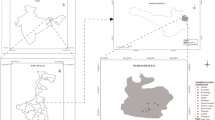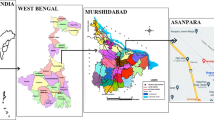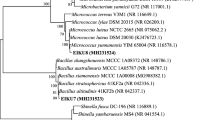Abstract
The aim of this study was to isolate arsenic-resistant bacteria and to further exploit it for remediation purposes. In the present study, we have isolated arsenic-resistant strain from ground water of Pakistan AT-01. The strain was cultivated at 37 °C in Luria Bertani broth supplemented with different concentrations of arsenate and arsenite. The minimum inhibitory concentration of arsenic against the bacterial isolate was 7 g/L (7000 mg/L) for arsenate and 1.4 g/L (1400 mg/L) for arsenite salt. The bacterial isolate was also characterized both on molecular and biochemical basis. The isolated strain belonged to the Pseudomonas aeruginosa. The high resistance against arsenic offered by the bacteria was exploited further for bioremediation purposes. The bacterial biomass generated from AT-01 strain was able to efficiently remove arsenic with 98% efficiency. Arsenic contamination of ground water is a widespread worldwide problem. The present study shows the potential of high arsenic-resistant bacteria for efficient arsenic removal.









Similar content being viewed by others
References
Andreoni V, Zanchi R, Cavalca L, Corsini A, Romagnoli C, Canzi E (2012) Arsenite oxidation in Ancylobacter dichloromethanicus As3-1b strain: detection of genes involved in arsenite oxidation and CO2 fixation. Curr Microbiol 65(2):212–218
Anikó K-P et al (2014) Bioadsorption characteristics of Pseudomonas aeruginosa PAOI. J Serbian Chem Soc 79(4):495–508
Ayoob S, Gupta AK (2006) Fluoride in drinking water: a review on the status and stress effects. Crit Rev Environ Sci Technol 36(6):433–487
Barros Júnior L et al (2003) Biosorption of cadmium using the fungus Aspergillus niger. Braz J Chem Eng 20(3):229–239
Bibi S, Kamran MA, Sultana J, Farooqi A (2016) Occurrence and methods to remove arsenic and fluoride contamination in water. Environ Chem Lett p. 1–25
Currell M, Cartwright I, Raveggi M, Han D (2011) Controls on elevated fluoride and arsenic concentrations in groundwater from the Yuncheng Basin, China. Appl Geochem 26(4):540–552
Douraghi M, Ghasemi F, Dallal MM, Rahbar M, Rahimiforoushani A (2014) Molecular identification of Pseudomonas aeruginosa recovered from cystic fibrosis patients. J Prev Med Hyg 55(2):50–53
Farooqi A, Masuda H, Siddiqui R, Naseem M (2009) Sources of arsenic and fluoride in highly contaminated soils causing groundwater contamination in Punjab, Pakistan. Arch Environ Contam Toxicol 56(4):693–706
Farooqi A, Fatima S, and Rasool A, Geochemistry of fluoride and arsenic in groundwater of District Vehari, Punjab, Pakistan
Felsenstein J (1985) Confidence limits on phylogenies: an approach using the bootstrap. Evolution 39(4):783–791
Fernández M, Morel B, Ramos JL, Krell T (2016) Paralogous regulators ArsR1 and ArsR2 of Pseudomonas putida KT2440 as a basis for arsenic biosensor development. Appl Environ Microbiol 82(14):4133–4144
Frank RS (2017) Handbook of water and wastewater treatment plant operations. CRC PRESS
Giri A et al (2013) Biosorption of arsenic (III) from aqueous solution by living cells of Bacillus cereus. Environ Sci Pollut Res 20(3):1281–1291
Goswami R, Mukherjee S, Rana VS, Saha DR, Raman R, Padhy PK, Mazumder S (2015) Isolation and characterization of arsenic-resistant bacteria from contaminated water-bodies in West Bengal, India. Geomicrobiol J 32(1):17–26
Huisman J, Weghuis MO, and Gonzalez-Contreras P (2011) Biotechnology based processes for arsenic removal.
Joshi D et al (2008) Arsenic accumulation by Pseudomonas stutzeri and its response to some thiol chelators. Environ Health Prev Med 13(5):257–263
Kruger MC, Bertin PN, Heipieper HJ, Arsène-Ploetze F (2013) Bacterial metabolism of environmental arsenic—mechanisms and biotechnological applications. Appl Microbiol Biotechnol 97(9):3827–3841
Kumar S, Stecher G, Tamura K (2016) MEGA7: molecular evolutionary genetics analysis version 7.0 for bigger datasets. Mol Biol Evol 33(7):1870–1874
Nei M and Kumar S (2000) Molecular evolution and phylogenetics. Oxford University Press
Ng K-S, Ujang Z, Le-Clech P (2004) Arsenic removal technologies for drinking water treatment. Rev Environ Sci Biotechnol 3(1):43–53
Pepi M, Volterrani M, Renzi M, Marvasi M, Gasperini S, Franchi E, Focardi SE (2007) Arsenic-resistant bacteria isolated from contaminated sediments of the Orbetello Lagoon, Italy, and their characterization. J Appl Microbiol 103(6):2299–2308
Pepi M, et al. (2011) Arsenic-resistant Pseudomonas spp. and Bacillus sp. bacterial strains reducing As (V) to As (III), isolated from Alps soils, Italy. 56(1): p. 29–35
Prabhakaran P, Ashraf MA, Aqma WS (2016) Microbial stress response to heavy metals in the environment. RSC Adv 6(111):109862–109877
Qin J, Rosen BP, Zhang Y, Wang G, Franke S, Rensing C (2006) Arsenic detoxification and evolution of trimethylarsine gas by a microbial arsenite S-adenosylmethionine methyltransferase. Proc Natl Acad Sci U S A 103(7):2075–2080
Saitou N, Nei M (1987) The neighbor-joining method: a new method for reconstructing phylogenetic trees. Mol Biol Evol 4(4):406–425
Sandhu SS (1976) Colorimetric method for the determination of arsenic (III) in potable water. Analyst 101(1208):856–859
Satyapal G et al (2016) Potential role of arsenic resistant bacteria in bioremediation: current status and future prospects. J Microb Biochem Technol 8(3):256–258
Scanlon BR, Nicot JP, Reedy RC, Kurtzman D, Mukherjee A, Nordstrom DK (2009) Elevated naturally occurring arsenic in a semiarid oxidizing system, Southern High Plains Aquifer, Texas, USA. Appl Geochem 24(11):2061–2071
Shaheen SM, Rinklebe J, Frohne T, White JR, DeLaune RD (2016) Redox effects on release kinetics of arsenic, cadmium, cobalt, and vanadium in Wax Lake deltaic freshwater marsh soils. Chemosphere 150:740–748
Shahid M, Khalid M, Dumat C, Khalid S, Niazi NK, Imran M et al (2017) Arsenic level and risk assessment of groundwater in Vehari, Punjab Province, Pakistan. Exposure and Health p. 1–11. https://doi.org/10.1007/s12403-017-0257-7
Shakoor MB et al (2015) Unraveling health risk and speciation of arsenic from groundwater in rural areas of Punjab, Pakistan. Int J Environ Res Public Health 12(10):12371–12390
Shakoor MB, Bibi I, Niazi NK, Shahid M, Nawaz MF, Farooqi A, Naidu R, Rahman MM, Murtaza G, Lüttge A (2018) The evaluation of arsenic contamination potential, speciation and hydrogeochemical behaviour in aquifers of Punjab, Pakistan. Chemosphere 199:737–746
Straub AC, Stolz DB, Vin H, Ross MA, Soucy NV, Klei LR, Barchowsky A (2007) Low level arsenic promotes progressive inflammatory angiogenesis and liver blood vessel remodeling in mice. Toxicol Appl Pharmacol 222(3):327–336
Acknowledgements
We thank Dr. Zobia Noureen for her technical support during this study.
Funding
This project is funded by the Higher Education Commission of Pakistan, grant no. 20-3777/R&D/HEC/14.
Author information
Authors and Affiliations
Corresponding author
Ethics declarations
Conflict of interest
The authors declare that they have no conflict of interest
Electronic supplementary material
ESM 1
(DOCX 64 kb)
Rights and permissions
About this article
Cite this article
Tariq, A., Ullah, U., Asif, M. et al. Biosorption of arsenic through bacteria isolated from Pakistan. Int Microbiol 22, 59–68 (2019). https://doi.org/10.1007/s10123-018-0028-8
Received:
Revised:
Accepted:
Published:
Issue Date:
DOI: https://doi.org/10.1007/s10123-018-0028-8




